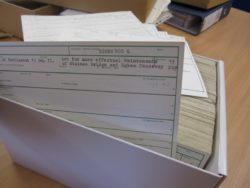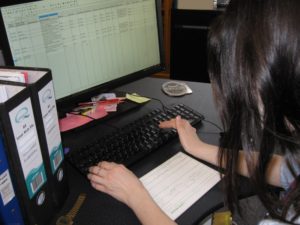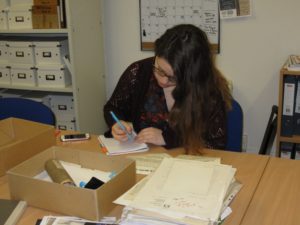Introducing…Our Cataloguing Crew!
For belated #MuseumPics day I thought I would introduce the wonderful people working behind the scenes at our museum, who are cataloguing the collection records for a more modern audience.
Cataloguing is a major focus for us at the museum. Hard-working volunteers trawl through the old cataloguing system, consisting of paper indexes and note cards to enter the data in the computer system. The system the museum is putting this information into is Modes Complete, which is a well-respected system for museum cataloguing.

The museum is fully accredited which includes cataloguing standards and takes pride in its original notecard system, which dates back to 1977 (just under a decade after the museum first opened). The notecards currently categorise different types of artefact, such as documents, photographs and prints. However, by inputting the information from the notecards into Modes Complete, everything will be completely accessible to the public, who will then be able to search to see if the museum has what they are looking for!
There is no denying it is a tough process, with around 18,000 information object notecards and 6,000-8,000 photographs alone, but our volunteers are generously donating their time to help bring the museum’s information system into the twenty-first century, and so I think they deserve a proper introduction.

First up is Roberta (Bobbi), who is originally from London and is studying Ancient History at Royal Holloway University. Bobbi has been volunteering at the museum for about a month now and mainly works in the cataloguing section. She decided to volunteer at the museum to gain work experience for the future, as museum work is the sector she wishes to pursue as a career, and also as part of her Duke of Edinburgh Gold Award. Her favourite period of history is Ancient Greece, and she is particularly interested in Greek Mythology, the subject upon which she is basing her dissertation next year.

Our second cataloguer is Amy, who is from Brighton and is about to finish her degree in French and History at Royal Holloway. Her favourite period of history is Victorian London, and the work she does at the museum includes cataloguing, writing articles and translating French documents into English. Amy has also been at the museum for approximately a month. She decided to volunteer at the museum to gain some experience of what it is like working in a small museum, as opposed to a larger one. Amy is also hoping to pursue museum work once she graduates – we wish her the best of luck!

Our third cataloguer is Pauline, who studied History of Art, History and Literature at the University of Surrey. She lives locally, and began to volunteer for the museum in 2006, where she initially researched the photograph collection to identify their use for museum displays. In 2010 Pauline began to help the Egham-by-Runnymede Historical Society with the organisation of their talks. She is a great supporter of Society and Museum activities, volunteering for both charities. Pauline, as part of our cataloguing team, is now helping to digitise the collection records.

Our last cataloguer is Bob, who has lived in Egham for twenty-two years and who manages the Staines, Egham and Englefield Green Appreciation Group on Facebook. (https://www.facebook.com/groups/172692419600246/) He began to volunteer at the museum after a fellow group member who already worked for the museum suggested he do so. Bob has been at the museum since June 2016. He has catalogued more than a staggering 1000 records and scanned nearly as many photographs to help update the collection system for public access.
The museum greatly appreciates the work of its cataloguers in the face of such a vast task, and is very excited for the time when all of the collection records will be fully accessible for public consumption!

